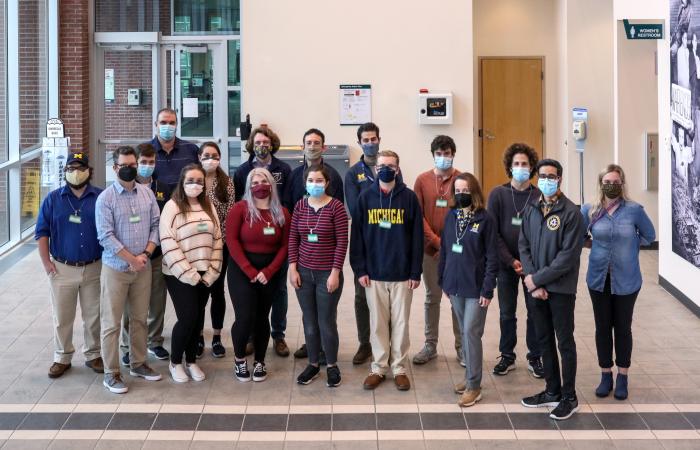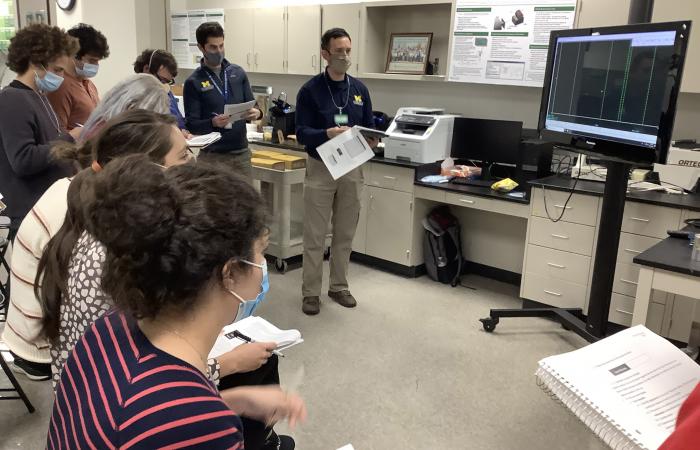-

Students from the University of Michigan pose for a group photo while visiting ORNL
-

University of Michigan students review data together in a group exercise on the nuclear fuel cycle.
-

Students from the University of Michigan pose for a group photo while visiting ORNL
-

University of Michigan students review data together in a group exercise on the nuclear fuel cycle.
As a graduate student at Purdue University, Robert Bean was steeped in the nuclear engineering world. He had a degree in nuclear science. He operated his school's nuclear reactor. And he advised undergraduates on career opportunities related to being a nuclear engineer. Yet he had never heard of "safeguards."
"I wasn't aware of how to apply an education in nuclear science outside of a reactor," said Bean, who now works in safeguards and nondestructive assay at Oak Ridge National Laboratory.
To ensure today's students learn about the variety of nuclear career paths before they graduate, ORNL's Nuclear Nonproliferation Division hosts workshops to help students of nuclear science find opportunities to make a national impact. The workshops are part of the National Nuclear Security Administration's (NNSA's) International Nuclear Safeguards Human Capital Development program, which was launched in 2008 to educate, attract, and retain the next generation of international nuclear safeguards experts.
"Within nuclear science and engineering, there are several career paths. Not everyone works in a reactor," said Jessica White-Horton, ORNL's lead for the Human Capital Development program. "From safeguards technology R&D to policy, there are opportunities for students interested in all types of careers."
As more universities began adding safeguard programs to their nuclear curriculum over the past decade, White-Horton and her team saw an opportunity to engage with nuclear science and engineering programs and their students.
"ORNL's nuclear professionals have built an intensive education outreach program that brings students to the Safeguards Laboratory and shows them true representations of field activities performed by International Atomic Energy Agency (IAEA) inspectors," White-Horton said. "Each workshop is customized to the needs and interests of each university partner and brings the best combination of exercises and practical applications for the group."
One of ORNL's frequent collaborators is the University of Michigan at Ann Arbor, which sends students to Oak Ridge every other year to experience the latest in nuclear sciences. During a recent week-long visit, Michigan students emulated an inspection by conducting physical checks, taking measurements, and learning what to do with the data. They also toured ORNL's world-class facilities including the High Flux Isotope Reactor, Spallation Neutron Source, and historic Graphite Reactor.
Depending on the specific course and program needs, students may also visit local organizations and businesses-including NNSA's nearby Y-12 National Security Complex and the University of Tennessee-to see multiple sides of the nuclear field. The synergy between classroom and practical application brings a challenging topic to life.
"The opportunity for our students to perform experiments on special nuclear materials, tour the national laboratory facilities, and interact with researchers on the front line has been a valuable and unique experience," said Professor Sara Pozzi, University of Michigan.
A group of University of Michigan nuclear engineering students visit ORNL in October 2021.
For his part, Bean hopes these workshops give students an early picture of what they can do with a degree in nuclear science or engineering.
"When students have this information, they can see a long career path with lots of opportunities," remarked Bean. "There's always a need for scientists interested in nonproliferation, safeguards, and policy. The exact need may change but it will never go away."






